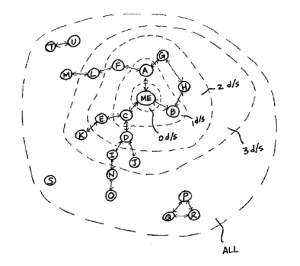Facebook Patents Social Search (Courtesy Of Friendster)
Has Facebook patented social search? It appears so, according to a patent awarded earlier this year by the USPTO. The patent, written the same year Facebook was founded, has been previously discussed but escaped our notice until now. Originally filed in October 2004 and awarded this past February, the patent is for a system that […]

Originally filed in October 2004 and awarded this past February, the patent is for a system that uses social connections and clicks within the network to determine search-ranking relevance. A piece in BNet calls the Facebook patent “curated search.” However we might as well call it a patent on “social search.” (See update below.)
Here’s what the abstract says:
Search results, including sponsored links and algorithmic search results, are generated in response to a query, and are marked based on frequency of clicks on the search results by members of social network who are within a predetermined degree of separation from the member who submitted the query. The markers are visual tags and comprise either a text string or an image.
Sure, the patent system is totally screwed up and patents are mostly used defensively against litigants. But let’s take this seriously for a moment.
The confusing name of patent 7,890,501 is “Visual tags for search results generated from social network information.” The BNet article argues the implications are “quite broad” and I agree.
Patents are often impossible to read let alone understand. However another excerpt from the patent filing seems to lay it all out pretty clearly. First here’s Facebook’s description of the way search is ranked now:
A key metric in evaluating the performance of search engines is relevance of the search results. Search engine developers are always striving to deliver search results that are relevant to the search query being processed. Consistent with this goal, there have been attempts to rank search results based on a number of different factors. One of the more popular ways to rank search results involves analyzing the location and frequency of keywords on a web page. Another frequently used technique is analyzing how web pages link to each other. A web page gets a ranking boost based on the number of other web pages that are linked to it. Click-through rates of search results are analyzed in some search engines. The general rule is: the higher the click-through rate, the higher the ranking.
Now here’s Facebook’s social search ranking methodology (partly repeating the excerpt above):
The invention provides still another technique to improve the relevance of search results. According to an embodiment of the invention, search results, including sponsored links and algorithmic search results, are generated in response to a query, and are ranked based on the frequency of clicks on the search results by members of social network who are within a predetermined degree of separation from the member who submitted the query. The predetermined degree of separation is equal to one if the click activities of only the friends of the member who submitted the query are to be examined.
A search result may also be marked based on its click history. In one embodiment, a search result is marked with an image or a text string if there was a single click on the search result by a friend of the member who submitted the query. In other embodiments, the frequency of clicks by members of social network who are within a predetermined degree of separation from the member who submitted the query is examined. If such frequency exceeds a minimum value, the associated search result is marked with an image or a text string.
Accordingly, Facebook’s patent factors in clicks and degrees of connection within the network to determine relevance.
Facebook was launched in February 2004. As mentioned, this patent was filed in October of that year. It would thus appear that Facebook has been thinking about search from the very beginning.
(Image from Facebook patent application)
Postscript: What’s not entirely clear, upon second thought, is whether activity “off SERP” (e.g., Twitter referrals or Facebook Likes) would fall within the coverage of this patent. This patent might implicate that sort of data — clearly the network exists outside the search engine — but Facebook may have been more narrowly contemplating activity (“clicks”) happening on or within the SERP. Facebook as a “platform” and the Like button were probably unforeseeable in October 2004.
Postscript2: Bill Slawski points out below in the comments, and I’ve since independently found this too, that the patent originated with Friendster and Facebook acquired it in an estimated $40 million deal last August when Friendster was sold. There were a wide range of patents in Friendster’s IP portfolio including, apparently, this one.
Related Entries:
- Google’s Search Results Get More Social; Twitter As The New Facebook “Like”
- Google Preparing To Launch Social “Circles” — Or Maybe Not
- Google’s Personalized Results: The “New Normal” That Deserves Extraordinary Attention
- Bing Results Get Localized & Personalized
- Google Social Search Goes Live, Adds New Features
- In The Wake Of Bing & Facebook, Google Web Search Tests Getting More Social
- Blekko, Bing & How Facebook Likes Are Changing Search
- Bing, Now With Extra Facebook: See What Your Friends Like & People Search Results
- Bing Expands Use Of Facebook ‘Likes’ In Search Results
- What Social Signals Do Google & Bing Really Count?
Contributing authors are invited to create content for Search Engine Land and are chosen for their expertise and contribution to the search community. Our contributors work under the oversight of the editorial staff and contributions are checked for quality and relevance to our readers. The opinions they express are their own.
Related stories